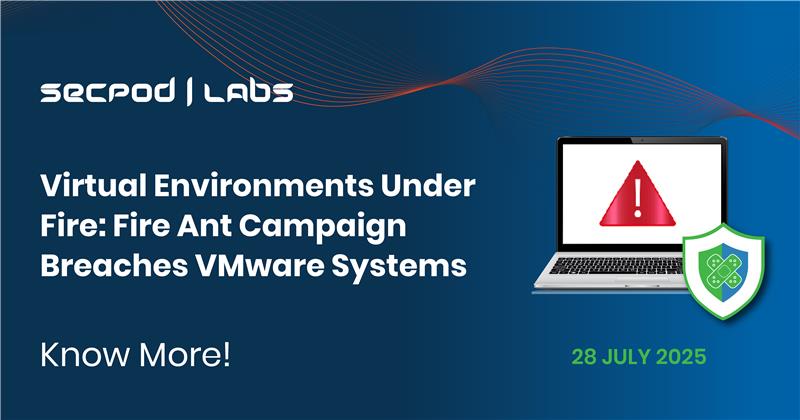A threat actor, codenamed Fire Ant, has targeted virtualization and networking infrastructure as part of a prolonged cyber-espionage campaign uncovered in 2025. The attackers focused on exploiting vulnerabilities and abusing trusted management tools to gain persistent, hypervisor-level access across entire environments. By compromising virtualization platforms and network appliances, Fire Ant could pivot into guest systems, extract sensitive data, and systematically bypass traditional security controls.
Executive Summary
- Since early 2025, a prolonged cyber-espionage campaign codenamed Fire Ant has actively targeted virtualization and networking infrastructure.
- The primary focus was on environments running VMware ESXi, vCenter, and critical network appliances, exploiting their central role in managing and connecting segmented networks.
- The attackers combined stealthy, multi-layered techniques to penetrate restricted network segments previously assumed to be isolated and secure.
- They demonstrated exceptional persistence and adaptability, responding quickly to defensive measures, redeploying toolsets, and maintaining access despite eradication efforts.
- The campaign’s tooling and attack patterns align with tactics observed in prior sophisticated threat activity, including exploiting known vCenter and ESXi vulnerabilities.
- Overall, Fire Ant highlights the urgent need for enhanced visibility and monitoring at the hypervisor and infrastructure layer, where traditional endpoint security solutions often lack coverage.
Vulnerability Details
CVE-2023-34048
1. Vulnerability: out-of-bounds write vulnerability
2. CVSS Score: 9.8 (Critical)
3. EPSS Score: 92.02%
4. Affected Products: VMware vCenter Server version 4.x, 5.x prior to KB88287, 7.0 prior to 7.0U3o and 8.0 prior to 8.0U1d and VMware Cloud Foundation version 4.x, 5.x prior to KB88287
CVE-2023-20867
1. Vulnerability: Authentication Bypass Vulnerability
2. CVSS Score: 3.9 (Low)
3. EPSS Score: 0.51%
4. Affected Products: VMware Tools 10.3.x, 11.x.x, 12.x.x
Infection Method
Initial Access
Attackers target internet-facing VMware vCenter servers and hypervisor management interfaces as the entry point into virtualization environments.
Exploitation
CVE-2023-34048 (vCenter DCERPC out-of-bounds write vulnerability):
- Attackers exploit an out-of-bounds write vulnerability in vCenter Server’s DCERPC protocol implementation.
- Specially crafted network requests allow unauthenticated remote code execution on vCenter, enabling the attackers to gain control over the virtualization management layer.
CVE-2023-20867 (VMware Tools authentication bypass):
- Attackers exploit an authentication bypass vulnerability that allows commands to be executed inside guest virtual machines from the hypervisor without valid in-guest credentials.
- By abusing PowerCLI host-to-guest features and modifying VMX process memory, attackers inject malicious commands directly into guest VMs.
Threat Capabilities
CVE-2023-34048 (vCenter DCERPC out-of-bounds write vulnerability)
- Unauthenticated remote code execution can be achieved on vCenter servers directly over the network.
- Deploy persistent backdoors on vCenter to maintain covert access even after reboots.
- Extract privileged service account credentials (e.g., vpxuser) to pivot from vCenter into connected ESXi hosts.
- Gain complete control over the virtualization management layer, allowing centralized orchestration of ESXi hosts and guest virtual machines.
- Use vCenter access to bypass lockdown modes and other direct host protections.
CVE-2023-20867 (VMware Tools authentication bypass)
- Execute arbitrary commands inside guest virtual machines without valid in-guest credentials, directly from the hypervisor.
- Deploy malware, credential-dumping tools, and tunneling frameworks (e.g., V2Ray) inside guest VMs without triggering user authentication.
- Tamper with or disable endpoint detection agents running inside guest operating systems.
- Dump sensitive data, including NTLM hashes and domain credentials, by accessing memory snapshots.
- Pivot from compromised guest VMs into broader internal networks, enabling lateral movement beyond the virtualization layer.
Impact
- Remote Code Execution: Enabled remote code execution, allowing attackers to run arbitrary commands on vCenter servers and directly inside guest virtual machines.
- Authentication Bypass: Allowed authentication bypass, letting attackers execute host-to-guest operations without valid in-guest credentials.
- Credential Harvesting: Facilitated credential harvesting by extracting privileged service account credentials and dumping passwords and hashes from guest memory, supporting lateral movement across the virtual and physical network environments.
Patch
- Upgrade vCenter Server to 7.0U3o or 8.0U2 or above
- Apply patch KB88287 on VMware Cloud Foundation version 4.x, 5.x
- Upgrade VMware Tools to 12.2.5 or later
Instantly Fix Risks with Saner Patch Management
Saner patch management is a continuous, automated, and integrated software that instantly fixes risks exploited in the wild. The software supports major operating systems like Windows, Linux, and macOS, as well as 550+ third-party applications.
It also allows you to set up a safe testing area to test patches before deploying them in a primary production environment. Saner patch management additionally supports a patch rollback feature in case of patch failure or a system malfunction.
Experience the fastest and most accurate patching software here.

